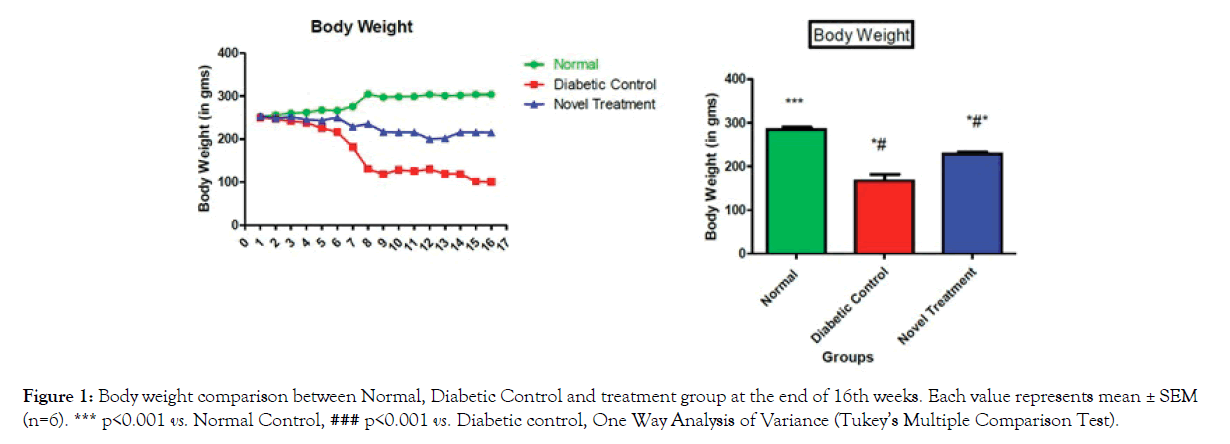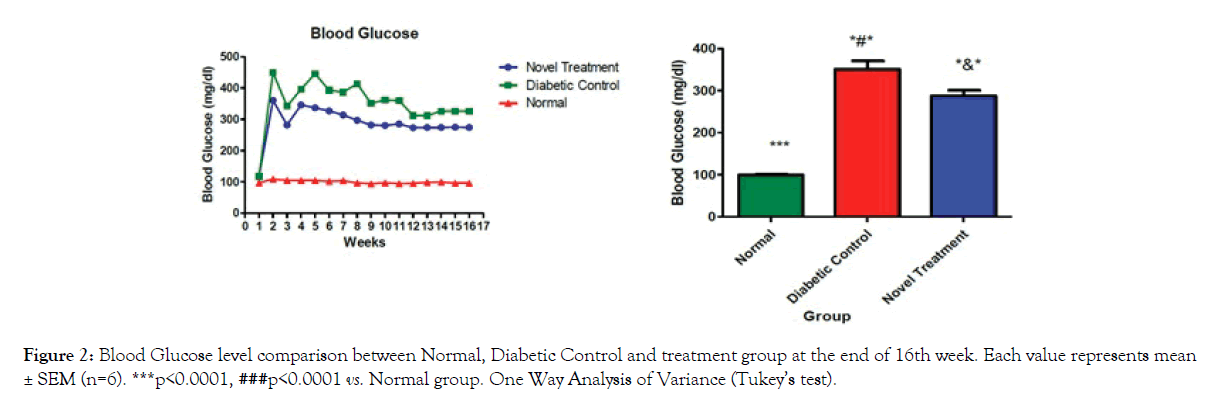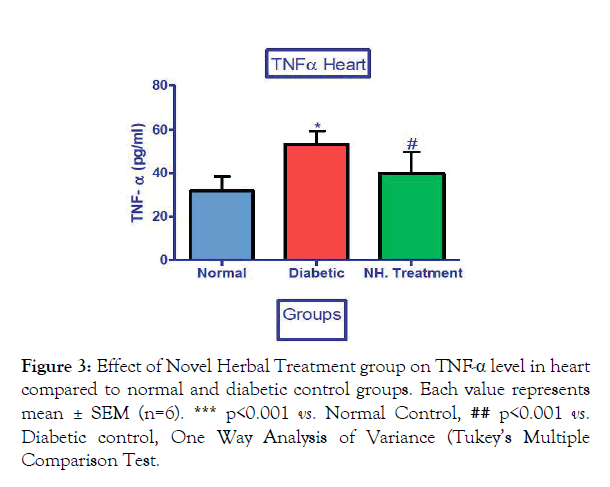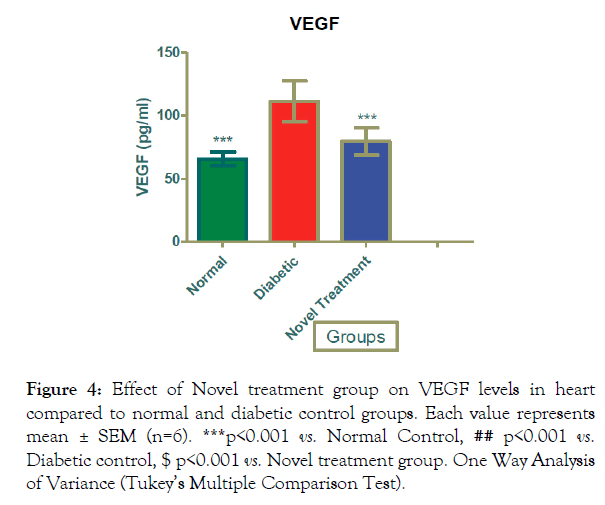
Biochemistry & Pharmacology: Open Access
Open Access
ISSN: 2167-0501

ISSN: 2167-0501
Research - (2019)Volume 8, Issue 2
Diabetes mellitus is extremely serious condition from both clinical and public health standpoints. Poor people in India do not have access to the resources needed to treat this condition. The recent decade has witnessed many landmark observations, which have added to the scientific credentials of Ayurveda system of India. The research was done to develop the novel herbal formulation with the antidiabetic and hypoglycaemic herbs described in various past research at Ocular Pharmacology lab DIPSAR. Wistar albino rats (150–200 g) of either sex were chosen to actuate Type-1 Diabetes. The animals were divided into three groups; two groups were injected with Streptozotocin (STZ) dissolved in citrate buffer (pH-4.5) at a dose of 45 mg/kg i.p. to induce diabetes. The third group served as normal control group and was injected only with citrate buffer (pH-4.5). Drug treatment was done for sixteen weeks with the Novel herbal formulation. The level of VEGF an TNF-α were further reduced significantly. Above results were further confirmed by histopathological findings. Thus, from the present study it is concluded that Novel herbal formulation may be of therapeutic and prophylactic value in the treatment of cardiomyopathy.
Diabetes mellitus; Public health; Hypoglycaemic; Ocular pharmacology; Cardiovascular
Long term uncontrolled hyperglycemia leads to fatal cardiovascular complications among the diabetic patients in developed and developing nations. It is claimed in several studies that in spite of absence of Coronary artery disease and Hypertension in Diabetic patients may leads to Heart failures. Patients with diabetes after a long time developed structural and functional changes in their myocardium cell. This condition is known as Diabetic cardiomyopathy. It is also perplexing that molecular mechanism and sequence of events leading to diabetic cardiomyopathy still elusive [1-5]. Chronic inflammatory level directly or indirectly leads to alteration in myocardium tissue fibrosis, necrosis and apoptosis [6]. Oxidative stress, in the diabetic heart, playas a key role in the development and progression of diabetic cardiomyopathy. It is supported by increased level of TNF-α, expression in the cell [7]. The disturbance in equilibrium between ROS and endogenous antioxidant reserve may lead to serious cardiac complications and remodeling of extracellular matrix in the cell [8]. Recently it was reported that Type I diabetes associated with the unique form of cardiomyopathy, present without atherosclerosis. Imbalance between Redox and alternation of vascular endothelial growth factor has been associated with this type of cardiomyopathy. Inflammation plays an important role in the pathogenesis of cardiovascular diseases [9]. Inflammation is a natural response to cellular injury. It is an important natural phenomenon for healing and tissue repair. However, inadequate or overwhelming inflammatory response could be a cause of inflammatory cytokines [7]. In the acute-phase response, cytokines which are like Interleukin-6 (IL-6) and tumor necrosis factor alpha (TNF-α) acts as inducing agent for the production of reactant proteins, including C-reactive protein, which is biomarker of acute myocardial injury in patients [10,11]. Further, TNF-α in its activated form plays a critical role in activating host defense mechanisms and in homeostatic tissue repair, but the overwhelming expression of TNF-alpha can diffuse inflammation and multi-organ dysfunction. In various studies, TNF-α is implicated in hypertrophic growth response and fibrosis in myocardium through the change of matrix metalloproteinases (MMPs) and tissue inhibitors of metalloproteinases (TIMPs) [12,13]. Various medicinal plants have been studied since time immemorable and reported to be effective in the management of diabetic microvascular complications [14]. The Ancient Ayurveda system (Based on scientific principles) mention the diabetes as Madhumeha, (referred to be the terminal stage of the disease in ancient texts) largely described under the broad heading of Prameha (means passing of excess urine both in frequency and quantity). Ayurveda also describes the first two forms of diabetes as Sahaja Prameha (Diabetes type I genetic disorders) and Apathyanimittaja Prameha (acquired Non-insulin dependent Type II diabetes) [15]. Literature search were done to find a hearb which is easily available and strongly recommended for Madhumeha in Ayurveda. For this a combination of five potent herbs mentioned Ginger, Tulsi, Haldi, Methi Powder and arjuna were taken as investigational drug for this study. The following Table 1 shows the complete details.
| Characteristics | Ginger | Tulsi | Haldi | Fenugreek | Arjuna |
|---|---|---|---|---|---|
| Botanical Name | Zingerber officinale | Ocimum tenuiflorum | Cucruma longa | Trigonella foenum-graecum | Termenalia Arjuna |
| Chief Chemical Compound | Itcontains Pungent Phenolic substances aromatic ketones Known collectively as gingerols. | Eugenol Methyl Eugenol |
Turmerone, α-turmerone, β-Turmerone | Trigonelline Diosgenin, Yamogenin, gitogenin |
Polyphenols, flavonoids, tannins, triterpenoids, saponins, sterols and minerals are the major constituents |
| Common Uses | Spice and flavouring agent | Medicine, Flavouring agent | Spice, Colouring Agent | Spices, Flavouring agent, laxative, digestive | Cardiotonic |
| Pharmacological Action | Antidiabetic, Anticancer, Antiinflammatory, Anti-oxidant |
Anticancer anti-inflammatory antidiabetic effects immunomodulatory radioprotective |
Antoxident antiinflammatory |
Hypoglycemic [17] Hypolipidemic [18] Insulinotropic [19] |
Heart toinc |
| Cardiovascular Action. |
aqueous ginger extract lowers BP through a dual inhibitory effect mediated via stimulation of muscarinic receptors and blockade of Ca++ channels and this study provides sound mechanistic basis for the use of ginger in hypertension and palpitations.[16] | Antioxident cardioprotective |
preventing atrial arrhythmias [20] | Cardioprotective | Cardiotonic |
Table 1: Showing details about the Pharmacologic and cardiotoniv Properties of investicational drugs.
Procurement of chemicals
Streptozotocin was purchased from Hi Media Laboratories, Delhi, India. Enzyme linked immunosorbent assay (ELISA) kits were purchased from RayBio® Ray Biotech, Inc., Georgia, USA. All other chemicals and reagents used were of analytical grade purchased from Merck Chemicals India unless otherwise mentioned [16].
Procurement of drugs of novel herbal formulation
Procurement of drugs of novel herbal formulation shows in Table 2.
| S. No | Herbal Drug | Supplier’s Name |
|---|---|---|
| 1. | Ocimum sanctum | Sanat, New Delhi |
| 2. | Zingiber officinalis | Sanat, New Delhi |
| 3. | Termenala arjuna | Sunpure, New Delhi |
| 4. | Curcuma longa | Sanat, New Delhi |
| 5 | Trigonella foenumgraecum | Fenfuro, New Delhi |
Table 2: Ingredients of Novel Herbal Formulation.
Dose selection
The dose was selected based on the previous research work done at Oculr lab and less than the maximum prescribed dose 3 g/kg body weight of animal (Table 2).
Study design
The protocol was approved by the Institutional Animal Ethics Committee (IAEC/2017-I/Prot. No.-02). Male Wistar albino rats (150-200 g) were used for the present study. Diabetes was induced with a single intraperitoneal injection of streptozotocin (45 mg/kg body weight. Forty eight hours post STZ injection blood glucose level was measured and rats showing a blood glucose level above 300 mg/dl were considered as diabetic and selected for the study. Diabetic rats were divided into two groups: group I received no treatment and group II received oral Novel Herbal Formulation at the dose mentioned in Table 2 by oral gavage soon after establishment of diabetes (48 h after administration of STZ) and continued for 16 weeks. The rats were monitored throughout the study for changes in body weight and blood glucose. The blood glucose and body weight of all rats were regularly monitored [17]. Diabetic rats and age-matched normal rats were sacrificed after sixteen weeks of diabetes, and the hearts were immediately removed and homogenized in ice cold phosphate buffer (pH 7.4) for biochemical estimation and hearts fixed for histological examinations done. All experimental procedures were performed in accordance with the guidelines of Committee for the Purpose of Control and Supervision of Experiments on Animals (CPCSEA, New Delhi, India) [18]. Animals were housed under controlled laboratory conditions at 21 ± 2°C, relative humidity 50 ± 15% and on a 12 h light/dark cycle. The rats were fed a standard rat chow diet and filtered drinking water ad libitum.
Estimation of biochemical parameters
At the end of 16 weeks of study period, animals from all the three groups were sacrificed by CO2 overdose the heart was isolated. Hearts were removed from each group and homoginized immediately or after storing at -40°C. All procedures done on 4°C on ice. Homogenate was prepared by mixing in Phosphate buffer using mechanically driven blades, followed by mechanical homozenization using Teflon pestle and manual ground glass homogenization [19]. Large particles were removed by centrifuging at 40 g for 1 min. The second pellet was resuspended in equal volume of PBS by manual ground glass homogenization, aliquoted and stored at -40°C. Biochemical inflammatory parameters like TNF-α and Cardiac Parameter VEGF were estimated by kits.
Glycemic parameter
Weekly blood glucose was measured using Accu-Chek Active Glucose Test Strips and Accu-Chek_ meter (RochDiagnostics India Pvt. Ltd) and this device was calibrated to confirm the accuracy before every use. Procedure followed based on the previous Experiments done at ocular lab.
Histopathological study
For histopathological analysis, the isolated heart was fixed in 10% formalin (phosphate buffered; pH 7.4). Four μm thin sections were cut perpendicular from apex to base of the left ventricle. The left ventricle sections are stained with hematoxylin-eosin (H&E) and wrapped in paraffin. The stained Sections were sent histopathological analysis, the isolated heart was fixed in 10% formalin (phosphate buffered; pH 7.4). Four μm thin sections were cut from the left ventricle and stained with hematoxylin-eosin (H&E). The stained sections were examined at 40 X magnification to investigate the histological changes in the diabetic heart in the presence and absence of Noval Herbal Treatment. Histological evaluation was performed by an independent clinical pathologist in blinded fashion [20,21].
ns were examined at 40 X magnification to investigate the histological changes in the diabetic heart in the presence and absence of Noval Herbal treatment. Histological evaluation was performed by an independent clinical pathologist in blinded to the identity of the sample examined.
Statistical analysis
All data are expressed as mean ± standard error mean (SEM), n=6 (number of sample size was 6 in each group). Statistical comparisons were made using one-way-analysis of variance (ANOVA) with post hoc analysis using Tukey’s multiple comparison test by Graph Pad Prism, Version-5. Value of p<0.05 was accepted as statistically significant.
Body weight
Body weights in diabetic rats were found to be significantly lower when compared to normal rats at the end of 16 weeks. However, body weight in Novel Herbal Formulation treated rats were comparitavely higher than untreated diabetic rats (p<0.001) (Figure 1).

Figure 1: Body weight comparison between Normal, Diabetic Control and treatment group at the end of 16th weeks. Each value represents mean ± SEM (n=6). *** p<0.001 vs. Normal Control, ### p<0.001 vs. Diabetic control, One Way Analysis of Variance (Tukey’s Multiple Comparison Test).
Blood glucose
Blood glucose in diabetic rats was found to be significantly lower when compared to normal rats at the end of 16 weeks. However, blood glucose in Novel Herbal Formulation treated rats was comparatively higher than untreated diabetic rats (p<0.001) (Figure 2).

Figure 2: Blood Glucose level comparison between Normal, Diabetic Control and treatment group at the end of 16th week. Each value represents mean ± SEM (n=6). ***p<0.0001, ###p<0.0001 vs. Normal group. One Way Analysis of Variance (Tukey’s test).
Effects of novel herbal formulation on biochemical parameters and cardiomyopathy biomarkers – TNF-α
TNF-α level was found to be significantly higher in the diabetic heart compared with normal hearts (p<0.001). However, Novel Herbal formulation treated hearts showed significantly lower expression of TNF-α compared to untreated diabetic rats (p<0.001) (Figure 3).

Figure 3: Effect of Novel Herbal Treatment group on TNF-α level in heart compared to normal and diabetic control groups. Each value represents mean ± SEM (n=6). *** p<0.001 vs. Normal Control, ## p<0.001 vs. Diabetic control, One Way Analysis of Variance (Tukey’s Multiple Comparison Test.
VEGF
As a hallmark of DCM, level of VEGF was significantly higher in diabetic control group compared to normal control (p<0.001). On the other hand Novel Herbal Treatment group showed significant fall in expression of VEGF (p<0.001) level (Figure 4).

Figure 4: Effect of Novel treatment group on VEGF levels in heart compared to normal and diabetic control groups. Each value represents mean ± SEM (n=6). ***p<0.001 vs. Normal Control, ## p<0.001 vs. Diabetic control, $ p<0.001 vs. Novel treatment group. One Way Analysis of Variance (Tukey’s Multiple Comparison Test).
Histopathological studies
Well-organized nucleus observed in Normal Heart, Cardiomyocytes showed regular arrangement of cardiomyocytes with uniform size of cell bodies and nuclei, uniform intercellular space was seen and clear stripes of cardiac fibers were observed. A marked disorganization of cardiac muscle fibers were observed in diabetic heart. Cardiomyocytes showed myofibrillar disarray, degenerated and scattered cardiac muscle fibers, myocardial fibrosis, coarse granules in cytoplasm, deformation of nucleus and swelling. Significant improvement in histopathological indices of injury was observed in diabetic rats treated with Novel Herbal formulation as compared to diabetic control rats. Novel herbal formulation treatment prevents the de-arrangement of myocardial cells and fibers as compared to diabetic control group (Figure 5).

Figure 5: (a) Normal Diabetic heart; (b) Degenerated Cardiac Heart; (c) Treatment Heart.
In the present study, after 48 hours of streptozocin injection the diabetic control showed a significant steep rise in blood glucose level (351 ± 30.5 mg/dl) compared to normal control group (99.5 ± 4.3 mg/dl) and required exogenous insulin injection on regular basis to control the blood glucose level (300-400 mg/dl). However, treatment groups were protected against the chronic elevated blood glucose levels (287 ± 2.74 mg/dl) and weight loss (198.5 ± 1.76) without any need of exogenous insulin opposite to their respective diabetic controls which needed exogenous insulin on regular basis. The expression of VEGF, TNF-α was significantly high in heart of diabetic rats compared to normal rats. However our drugs showed marked cardioprotective effect. The level of various biomarkers in diabetic rats treated with Novel Herbal combination was close to normal control group compared to diabetic control rats. On histopathological examination normal control group heart showed well organised nucleus and cardiac fibres, while diabetic control group heart showed marked disorganisation of cardiac muscle fibres but the Novel Herbal treatment group heart showed arrangement of fibres nearly similar to normal control group. Results of histopathological examination further bolster our claim by providing the evidence, that drug halted the structural abnormalities afoot due to chronic insult of hyperglycaemia. The present study investigated the possible combined effect of Novel Herbal Combination in diabetes induced Cardiomyopathy. The streptozotocin (STZ) (45 mg/kg, i.p., once) was administered in rats to induce experimental diabetes. The development of diabetic Cardiomyopathy and nephropathy was assessed biochemically by estimating the TNF-α and VEGF. Further, the histopathological study was performed to analyze the structural changes in the cardiac tissue. In addition, the Blood glucose was accesed by accu ckeck active for sixteen weeks. The Trigonella foenum granulum (1 g/kg/day.) Curcuma longa (200 mg/kg/day.), Zingiber officinalis (75 mg/kg), Termeanilia arjuna (500 mg/kg,) and Ocimum sanctum (50 mg/kg) treatments were started in diabetic rats after 1 week of STZ administration and continued for 7 weeks. On the basis of results obtained in the present study, the following salient findings are the single administration of STZ produced diabetes, which induced cardiac oxidative stress the cardiomyopathy was noted to be developed in the diabetic rat that was assessed in terms of increase in serum creatinine in terms of biomarkers and histopathological damage. Treatment with novel Herbal Combination the prevents the changes observed in Diabetic Group.
Diabetes, a disease known to us for many millennia, leads to serious morbidity and mortality in humans. Despite significant progress in Diabetes and the development of antidiabetic drugs, no cures have been found. Medicinal herbs, long used in alternative and complementary medicine systems, are an extremely rich source of Diabetic remedies. Currently, understanding of the mechanisms through which herbal therapies mediate Diabetes is evolving, and they are generally being viewed as modulating of multiple metabolic pathways. Based on safety and their multiple targeting actions, herbal therapies are potent therapeutic means in Diabetes. Here, we summarized the Novel Herbal Combination that have been demonstrated to prevent and treat Diabetes via the regulation of insulin resistance, -cell function, incretin pathways, and glucose (re)absorption. In addition, the actions, mechanisms and therapeutic potential of plant compounds and/or extracts, and new insights into the advantage of herbal therapy, which simultaneously governs distinct metabolic pathways immune cells and cells, were discussed for Diabetes. Systematic information about the structure, activity, and modes of action of these plants and compounds will pave the way for research and development of antidiabetic drugs.
Citation: Gond AK, Gupta SK (2019) Evaluation of the Novel herbal formulation for its cardioprotective action against streptozotocin induced Diabetes in Rats. Biochem Pharmacol (Los Angel) 8:266. doi: 10.35248/2167-0501.19.8.266
Received: 18-Dec-2017 Accepted: 30-May-2019 Published: 06-Jun-2019 , DOI: 10.35248/2167-0501.19.8.266
Copyright: © 2019 Gond AK, et al. This is an open-access article distributed under the terms of the Creative Commons Attribution License, which permits unrestricted use, distribution, and reproduction in any medium, provided the original author and source are credited.